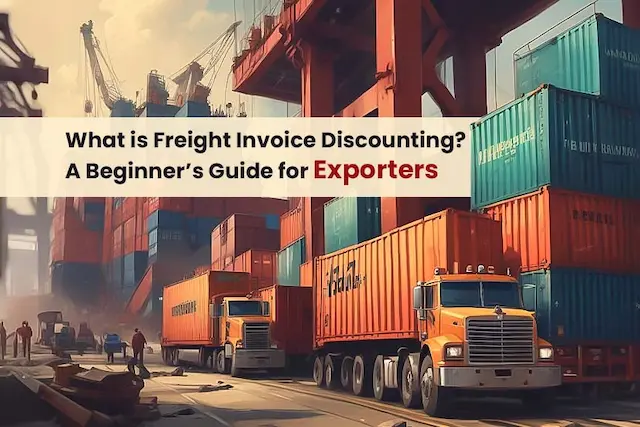Exporting operates within a complex and volatile global landscape where managing cash flow risk and overall international trade risk must always be considered. The method of payment and financing for an export transaction is important for day-to-day operations, as well as to allow scope for expansion outside its domestic market. There are various options, and trade credit and bill discounting are two of the most common ways. This guide provides a trade credit vs bill discounting comparison, highlighting their pros and cons, and the issues exporters should evaluate in advance of selecting the best option for them.
Understanding Trade Credit and Bill Discounting
Trade credit is when the exporter ships goods, and the buyer is permitted to pay for them at a later stage. This is advantageous for the buyer’s financial flexibility, but during the buyer’s credit period, the capital of the exporter is tied up. The sale will be recorded as accounts receivable until the buyer’s payment is cleared, therefore creating possible trade credit risks.
Bill discounting is a process of short-term finance. After the exporter ships the goods to the buyer and raises an invoice on the buyer, the exporter can sell the unpaid bill to banks or other financial institutions that will discount it and offer the exporter a discounted value. This is one of the most useful export finance options.
Trade Credit vs Bill Discounting: A Comparative Framework
Before diving into the pros and cons of each, here is a comparative trade credit vs bill discounting comparison table explaining key differences:
| Criteria | Trade Credit | Bill Discounting |
| Mechanism | Exporter extends credit to the buyer; payment deferred. | Exporters sell an unpaid invoice to a financier for upfront cash. |
| Cash Flow Impact | Cash outflow delayed; working capital tied up. | Immediate cash inflow after discounting improves liquidity. |
| Balance Sheet Effect | Recorded as accounts receivable; increases liabilities. | Not recorded as a loan; healthier financial ratios. |
| Risk Exposure | Exporter bears full buyer default risk. | Exporters retain default risk but get upfront cash. |
| Buyer Involvement | Fully aware and manages payment to the exporter. | Usually unaware, the exporter manages collections. |
| Operational Control | Exporter responsible for credit assessment and collections. | An exporter usually handles collections, but with the financier’s support. |
| Costs | No direct financing cost, but risk of bad debts. | Discount fee charged by financier; cost depends on credit rating. |
| Documentation | Simple, contractual payment terms. | Moderate documentation; involves a financier. |
Pros and Cons of Trade Credit for Exporters
Trade credit is often utilized to attract buyers and generate sales, but there are certain trade credit risks, too.
Benefits of Trade Credit
- Provides exporters with payment flexibility, making their offer more attractive in competitive environments in the international market.
- Aid in building long-term buyer relationships and loyalty through trust-based credit.
- No immediate financing costs due to receipt of funds upon invoice payment.
Disadvantages of Trade Credit
- Exporters may be exposed to delayed cash inflow, which increases working capital requirements due to cash flow issues.
- Trade credit risks with possible buyer insolvency or late payment, causing bad debt losses.
- Requires a strong credit assessment and collections process to mitigate risk.
- Large positions of receivables may impact financial ratios and borrowing capacity.
Pros and Cons of Bill Discounting for Exporters
Bill discounting provides exporters with a quick way to access receivables in cash, making it a popular choice in export payment methods.
Advantages of Bill discounting
- Quick liquidity for immediate cash, improving working capital, and decreasing cash flow gaps.
- Non-debt method for risk management; it does not look like a debt on the balance, so working capital ratios do not change.
- The arrangements for bill discounting for exporters are faster due to the limited amount of documentation requests than a loan facility arrangement.
- Private transaction and financing is not disclosed to buyers, meaning business credibility is maintained and confidentiality exists.
- The benefits of bill discounting enable the business to be in the fast lane while providing aid for the recycling of working capital.
Disadvantages of Bill discounting
- The discount fee reduces the net amount received relative to the total invoice value.
- The exporter bears the default risk if the buyer does not pay at maturity.
- Risky transaction unless the exporter has a trusted financial partner, along with a thorough review to uncover hidden fees.
- More complex administration than straight trade credits, as it requires coordination of financiers.
Understanding Trade Credit Risk and Mitigation Solutions
Trade credit risk is entirely about the possibility of a buyer defaulting or taking longer to pay than agreed. Exporters might work to mitigate trade credit risks by:
- Conducting comprehensive assessments of buyers’ creditworthiness before granting credit extension.
- Export credit insurance protects them from buyers’ defaults related to insolvency or geopolitical risk.
- Setting terms of contracts, and instigating and monitoring timely accounts receivable.
- Diversifying the buyer portfolio to reduce heavy reliance on one or a few customers.
- Establishing credit limits on a per-customer basis related to their risk profile.
- Using secure export payment methods like letters of credit to guarantee the payment to the exporter by the buyer, enabled by bank guarantees.
- Accessing credit reports and trade references to track a buyer’s financial standing regularly.
- Use escrow payment arrangements for the new or risky international buyer until obligations have been completed.
When to Choose Bill Discounting Over Trade Credit?
Exporters may have bill discounting as an alternative to trade credit when the following conditions exist:
- The exporter requires financing immediately to finance production, operations, or new orders, and can’t wait for payment from the buyer.
- The exporter is growing and needs a consistent cash flow to efficiently continue to grow.
- They want to minimize working capital tied up in receivables and improve their financial statements.
- The exporter is confident in the buyer’s creditworthiness and can actively follow up on collections.
- They want to reinvest in their business quickly, whether it is for marketing, expansion, or raw material purchases.
- They want to take advantage of supplier early payment discounts, with cash freed up from receivables.
Powering Export Growth with Smart Finance
When deciding between trade credit and bill discounting, exporters need to balance buyer relationships with financial stability. Trade credit could help in securing business, but it can put pressure on cash flow, exposing the exporter to liability. The use of bill discounting may alleviate cash flow stress and give exporters a better financial footing and potential for long-term success.
Credlix fills that gap with innovative export finance options to exporters so they can access cash quickly and securely. With Credlix, exporters have a finance partner who understands the global trade landscape to support exporters in their international expansion.
Accelerate your export journey with agile finance solutions from Credlix!





